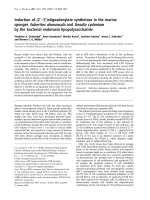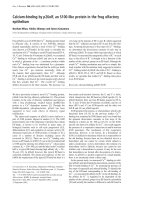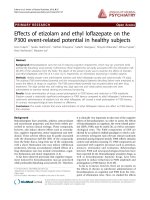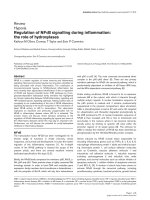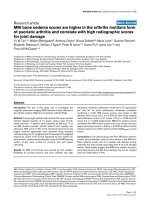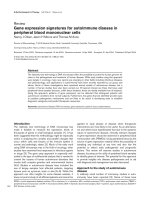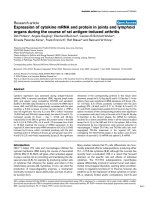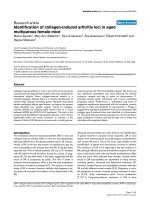Báo cáo Y học: Calcium-binding by p26olf, an S100-like protein in the frog olfactory epithelium pot
Bạn đang xem bản rút gọn của tài liệu. Xem và tải ngay bản đầy đủ của tài liệu tại đây (581.04 KB, 8 trang )
Calcium-binding by p26olf, an S100-like protein in the frog olfactory
epithelium
Naofumi Miwa, Yukiko Shinmyo and Satoru Kawamura
From the Department of Biology, Graduate School of Science, Osaka University, Japan
Frog p26olf is a novel S100-like Ca
21
-binding protein found
in olfactory cilia. It consists of two S100-like domains
aligned sequentially, and has a total of four Ca
21
-binding
sites (known as EF-hands). In this study, to elucidate the
mechanism of Ca
21
-binding to each EF-hand (named EF-A,
-B, -C and -D from the N-terminus of p26olf), we examined
Ca
21
-binding in wild-type p26olf and also in its mutants
in which a glutamate at the –z coordinate position within
each Ca
21
-binding loop was substituted for a glutamine.
Flow dialysis experiments showed that the wild-type binds
nearly four Ca
21
per molecule maximally, while all
the mutants bind approximately three Ca
21
. Although
EF-B and -D are p26olf-specific EF-hands and their role in
Ca
21
-binding is not known, the result unequivocally showed
that they actually bind Ca
21
. The overall Ca
21
-binding
affinity decreased in the three mutants. The decrease was
very large in the mutants of EF-A and -B, which suggested
that the Ca
21
-affinities are high in EF-A and -B in the wild-
type. Assuming the presence of four steps of Ca
21
-binding,
we determined the dissociation constant of each step in
wild-type p26olf. To assign which step takes place at which
EF-hand, we measured the antagonistic effect of K
1
on each
step, as the effect of K
1
is thought to be a function of the
number of the carboxyl groups in an EF-hand. Although the
actual Ca
21
-binding mechanism may not be so simple, this
study together with the mutation study suggested a tentative
Ca
21
-binding model of p26olf: the order of Ca
21
-binding to
p26olf is EF-B, EF-A, EF-C and EF-D. Based on these
results, we speculate that similar Ca
21
-binding takes place
in an S100 dimer.
Keywords: calcium-binding; p26olf; S100.
We have previously isolated a novel Ca
21
-binding protein,
p26olf, from the frog olfactory epithelium [1]. This protein
localizes in the cilia of olfactory epithelium and interacts
with a frog b-adrenergic receptor kinase (bARK)-like
protein in a Ca
21
-dependent manner [2]. Through the
bARK-dependent phosphorylation, p26olf has been
suggested to have some role(s) in olfactory signal
transduction.
The amino-acid sequence of p26olf is most similar to a
pair of S100 proteins aligned in tandem [1,3]. The S100
protein family, one of the subgroups of proteins that contain
EF-hands, is known to be involved in many types of
biological function such as cell-cycle progression [4,5],
differentiation [6,7] and regulation of enzyme activity [8].
Abnormal expression of S100 proteins is thought to be a
cause of a number of diseases including cancer [9]
(reviewed in [10,11]). There are two Ca
21
-binding sites,
known as EF-hands, in S100 [12]: one in the N-terminal half
is S100-specific showing low affinity for Ca
21
(dissociation
constant, K
d
¼ 200–500 mM) and the other in the C-terminal
half is a typical EF-hand showing high affinity (K
d
¼ 20–
50 m
M) [13]. In p26olf, however, this typical EF-hand is
somewhat modified. The amino-acid sequence of this site
fulfills the requirement of the typical EF-hand but there is a
four-amino-acid-insertion between the E and F a helix,
which characterizes this EF-hand as p26olf-specific [3]. In
p26olf therefore there are four EF-hands (named as EF-A,
-B, -C and -D from the N-terminus of p26olf), and two of
them (EF-A and -C) are S100-specific and the other two
(EF-B and -D) are p26olf-specific.
S100 proteins form a homo- or a heterodimer, which is the
functional form [14,15]. In the previous studies, Ca
21
-
binding was examined in S100 dimers and it was found that
the apparent dissociation constants in four steps of the
binding in a dimer are 20–100 m
M [16,17]. As the S100-
specific site shows low affinity for Ca
21
, this result suggests
the presence of a cooperative interaction in and/or between
S100 monomers. The mechanism of this cooperative
interaction, however, is not known. In a homodimer of
S100, it is difficult to determine which site is responsible for
the nth binding, because there are two identical sites in a
homodimer and one cannot be certain which subunit is
under consideration. As for a heterodimer, the isolation of a
heterodimer itself is difficult, because one cannot be sure
whether only a heterodimer is present. It may be the case
that homodimers are formed after dissociation of a hetero-
dimer. As p26olf is a protein composed of a single peptide,
there is no uncertainty about a dimer state.
In the present study, we measured Ca
21
-binding in wild-
type p26olf, and determined the dissociation constants of the
first to fourth binding of Ca
21
by assuming the presence of
four steps of sequential and ordered binding. To identify the
site of the EF-hand corresponding to the nth binding of
Ca
21
, we measured the affinity for K
1
in the nth binding. As
the affinity for K
1
is suggested to be dependent on the
number of the carboxyl groups in an EF-hand in calmodulin
[18] and actually the number is different in each EF-hand in
Correspondence to S. Kawamura, Department of Biology, Graduate
School of Science, Osaka University, Machikane-yama 1-1, Toyonaka,
Osaka 560 0043, Japan. Fax: 1 81 6 6850 5444,
Tel.: 1 81 6 6850 5436, E-mail:
(Received 15 June 2001, revised 7 September 2001, accepted
12 September 2001)
Abbreviations: bARK, b-adrenergic receptor kinase.
Eur. J. Biochem. 268, 6029–6036 (2001) q FEBS 2001
p26olf, we can possibly identify the site of the EF-hand
responsible for the nth binding of Ca
21
in p26olf. In
addition, to examine how each EF-hand contributes to
Ca
21
-binding in p26olf, we measured Ca
21
-binding in four
mutants each of which has a Glu !Gln mutation at the –z
coordination position. Based on these results, we will
discuss the order of Ca
21
-binding to p26olf.
EXPERIMENTAL PROCEDURES
Ca
21
-binding studies
Recombinant p26olf was prepared as described [1]. Protein
concentration was determined by densitometry using a
laser densitometer (Molecular Dynamics). To measure the
stoichiometry of Ca
21
-binding to p26olf, we performed flow
dialysis experiments as previously described [2]. Briefly, we
incubated p26olf (final concentration; 10 m
M) in a 20-mM
Tris/HCl buffer (pH 7.5) at 20 8C with various concen-
trations of
45
CaCl
2
(6.2 Â 10
2
Ci
:
mmol
21
) at KCl concen-
trations that depended on the type of the experiment. Unless
otherwise stated, the Tris buffer always contained 100 m
M
KCl in the present study. The reaction mixture was placed in
a prewashed microconcentrator (Microcon, Amicon) and
then it was centrifuged briefly. We counted the activities of
45
Ca in 4 mL portions of both the reaction mixture and the
filtrate using a scintillation cocktail (Clearzol; Nacalai,
Kyoto, Japan). By comparing the activities of
45
Ca in the
reaction mixture and the filtrate, the amount of Ca
21
bound
to p26olf was calculated. Blank experiments without p26olf
were performed to correct for nonspecific binding of Ca
21
to the membrane of microconcentrators. The Ca
21
concentration in each reaction mixture was calibrated with
aCa
21
electrode using diluted solutions of a 20-mM CaCl
2
solution (Sigma).
The raw data were analyzed with the Hill equation [19],
the Scatchard plot [20], and then, the Adair equation [21].
The Adair equation is represented as follows.
R ¼
1
K
1
x 1 2
1
K
1
1
K
2
x
2
1 ::: 1 n
1
K
1
1
K
2
:::
1
K
n
x
n
=
1 1
1
K
1
x 1
1
K
1
1
K
2
x
2
1 ::: 1
1
K
1
1
K
2
:::
1
K
n
x
n
Where R is the molar ratio of bound Ca
21
to p26olf at a free
Ca
21
concentration x, and K
1
, K
2
, and K
n
are the macro-
scopic dissociation constants for the binding of one and two,
and n Ca
21
to p26olf in a reaction of
CD measurement
CD spectra of wild-type p26olf and mutants (final
concentration; 10 m
M each) were measured with a Jasco
J-720 W spectrophotometer with 1-mm light path in Tris
buffer containing 100 m
M KCl. The Ca
21
concentration was
varied using a Ca/EGTA buffering system [2] and was
calibrated fluorometrically with the following two calcium
indicators: below 10 m
M Ca
21
, we used fluo-3 (Dojin,
Kumamoto, Japan), and over 10 m
M Ca
21
, fluo-3FF
(Calbiochem). The CD spectra were recorded in the region
of 200–250 nm at 0.1 nm interval, scan speed of
10 nm
:
min
21
, response time of 4 s, and at 20 8C. The
spectrum of each sample was measured twice and they were
averaged.
Construction of mutated expression vectors and
expression of mutants of p26olf
To generate a series of mutants of p26olf, we did site-
directed mutagenesis according to the methods of Tachi-
banaki et al. [22]. We used the following oligonucleotides
and the complementary oligonucleotides as PCR primers:
AACTTCAAA
CAGTTTGAGCAG for EF-A-mutation,
GACTTTCAA
CAGTTTCTCAAC for EF-B-mutation, GAT
TACACA
CAGTTCGAGGCA for EF-C-mutation, AATTT
CCAG
CAGTTCATGAAC for EF-D-mutation. The under-
lined codons show the sites of mutations, replacing
glutamate (E) with glutamine (Q). After PCR reactions,
the mutated DNA fragments were digested with Nde I and
Bam HI and inserted into pET3a (Novagen), and these
recombinant plasmids were introduced into Escherichia coli
BL21 pLysS (Novagen). After induction of the expression of
p26olf by isopropyl thio-b-
D-galactoside, p26olf-mutants
were purified according to the method of purification of
native p26olf [1].
RESULTS
Ca
21
-binding to p26olf
In p26olf, two S100 homolog domains are located sequen-
tially in the molecule [1,3]. S100 proteins are generally
known to form a homo- or a heterodimer in solution [14,15],
but in some experiments the recombinant S100 protein
formed a trimer [17]. Therefore, it could be the case that our
recombinant p26olf prepared here might form a dimer. If it
is present, interpretation of the results of Ca
21
-binding may
be complicated. Therefore, to exclude this possibility
we performed gel filtration column chromatography and
confirmed that our p26olf exists as a monomer; purified
p26olf eluted through the column as a single peak with a
molecular mass of < 28 kDa in the absence of Ca
21
, and
< 16 kDa in the presence of Ca
21
(data not shown).
Because the calculated molecular mass of p26olf is
< 24 kDa [1], this result indicated that p26olf exists as a
monomer in our solution.
In order to determine the affinity for Ca
21
and the
cooperativity of Ca
21
-binding to p26olf, we next analyzed
the stoichiometry of Ca
21
-binding to p26olf by flow dialysis
in the Tris buffer. Ca
21
-binding to p26olf as a function of
6030 N. Miwa et al. (Eur. J. Biochem. 268) q FEBS 2001
free Ca
21
concentration is shown in Fig. 1. Because p26olf
tends to aggregate at high concentrations, we used 10 m
M
p26olf in a Ca
21
-binding experiment. Due to this limitation
of the concentration of p26olf, we considered Ca
21
-binding
to p26olf below < 200 m
M Ca
21
. Above this concentration
of Ca
21
, the Ca
21
-binding signal (at most 40 mM, see
below) was within a noise level of the total Ca
21
concen-
tration and therefore, the result would not be reliable.
The binding data showed that the maximum number of
Ca
21
-binding to p26olf is approximately four per molecule
(Fig. 1), and therefore we fitted the data with the Hill
equation by assuming that p26olf has four Ca
21
-binding
sites. The fitted curve (solid line in Fig. 1) showed a
reasonable fit to the experimental binding data with the K
Ca
d
value of 22.3 mM and the Hill coefficient of 2.0 [in order to
distinguish the K
d
value determined by the Ca
21
-binding
studies and that determined by the CD measurement (see
below), we added the superscript Ca or CD to the term of
K
d
]. The convex curve observed in the Scatchard plot of the
binding data clearly indicates the presence of a positive
cooperativity (see inset in Fig. 1).
To estimate the dissociation constants in the Adair
equation (see Experimental procedures), we performed the
curve fitting by assuming the presence of four steps of
Ca
21
-binding. The theoretical curve (dashed line in Fig. 1)
fitted well to the binding data with K
1
¼ 83.3 mM,
K
2
¼ 6.3 mM, K
3
¼ 22.2 mM and K
4
¼ 50 mM, for example,
but due to the experimental errors of the measurement, we
could not determine the four dissociation constants
uniquely. However, after many trials, we reasonably con-
cluded that the dissociation constants had a tendency of
K
2
, K
3
ø K
4
, K
1
. The Adair dissociation constants
obtained were slightly larger than those obtained in S100
dimers [16]. This is because in the study in Fig. 1,
Ca
21
-binding was measured in the presence of 100 mM K
1
that is known to reduce the affinity for Ca
21
(see below).
Effect of K
1
on Ca
21
-binding to p26olf
The antagonistic effect of K
1
on Ca
21
-binding was observed
in many of Ca
21
-binding proteins such as S100 and
calmodulin [16,18]. Interestingly, Haiech et al. assumed that
the affinity for K
1
is a function of the number of the
carboxyl groups in an EF-hand [18], and their rationale is in
good agreement with the actual sequence of Ca
21
-binding
[23]. Although their assumption should be tested in other
Ca
21
-binding proteins, we here assumed that a similar
analysis can be applied to p26olf. Thus, we determined the
affinity for K
1
in each step of the Adair equation by
changing the K
1
concentration in order to identify which
Adair dissociation constant (K
1
–K
4
) corresponds to which
EF-hand.
As shown in Fig. 2, the maximum number of Ca
21
-binding
was nearly four per molecule at all the K
1
concentrations
tested. Assuming the presence of four Ca
21
-binding sites,
the data were first fitted by the Hill equation. As a result, we
obtained K
d
Ca
values of 22, 15.0 and 12.1 mM, and the Hill
coefficients of 2.0, 1.9 and 1.7 at 100 (Fig. 1), 20 and 0 m
M
K
1
, respectively (inset in Fig. 2). Because K
1
increased the
K
Ca
d
values in the Hill equation, K
1
competed with Ca
21
for
the EF-hands of p26olf similarly as in the cases of S100 and
calmodulin [16,18].
The data were then fitted by the Adair equation and the
determined dissociation constants (K
1
–K
4
) are summarized
in Fig. 3. To calculate the dissociation constant for K
1
in
each step, step 1 for example, we fitted the data of K
1
at
different K
1
concentrations with the equation of K
iapp
¼ K
i
(1 1 [K
1
]/k
i
) [18]. In the equation, K
iapp
is the calculated
Adair dissociation constant at step i in the presence of K
1
,
K
i
is the Adair dissociation constant at 0 mM K
1
, and k
i
is
the intrinsic dissociation constant for K
1
at step i. The
calculated result showed that the affinity for K
1
is high in
steps 1 and 4, and low in steps 2 and 3 (see the k values in
Fig. 1. Ca
21
-binding to p26olf. The amount of Ca
21
bound to p26olf
in the Tris buffer containing 100 m
M KCl is shown as a function of free
Ca
21
concentration. The experimental points represent the average of
16 different experiments using three different preparations of p26olf.
Each bar represents the standard deviation. The data were fitted to the
Hill equation (solid line) and the Adair equation (dashed line). The
index of the fit represented as the coefficient of correlation (r
2
) is 1.0 in
both the fitting to the Hill equation and to the Adair equation.
Fig. 2. Effect of K
1
on Ca
21
-binding to p26olf. Ca
21
-binding to
p26olf was examined at 100 m
M KCl (circles), 20 mM KCl (triangles)
and 0 m
M KCl (crosses). The data points of 20 mM KCl represent the
average ^ SD (n ¼ 12) of three different preparations of p26olf, and
those of 0 m
M KCl represent the average ^ SD (n ¼ 5) of two different
preparations. The data were fitted to the Hill equation (solid line, see
text). The r
2
values are 0.99 (100 mM KCl), 1.0 (20 mM KCl) and 1.0
(0 m
M KCl).
q FEBS 2001 Calcium-binding by p26olf (Eur. J. Biochem. 268) 6031
Fig. 3). Due to the experimental errors, we could not
determine the k-values uniquely, but our best estimate was
k
1
ø k
4
,, k
2
ø k
3
. These results suggested that the steps
1 and 4 take place in EF-hands which have many carboxyl
groups in the EF-hand motif (see Discussion).
Effect of K
1
on Ca
21
-induced conformational change of
p26olf
Our previous CD measurement in the absence of K
1
showed
that Ca
21
-binding to p26olf increases the negative signal at
both 210 nm and 222 nm [2]. As K
1
reduces the affinity
for Ca
21
, we measured CD spectra in the presence of
100 m
M K
1
as a function of Ca
21
concentration. At all
Ca
21
concentrations, negative CD signals increased in a
Ca
21
-dependent manner (inset in Fig. 4). Figure 4 shows
the percent change of CD at 222 nm (signal of a helix)
plotted as a function of the free Ca
21
concentration (lower
axis) and the number of the bound Ca
21
per p26olf molecule
(upper axis, nCa
21
) calculated from the binding data in
Fig. 1 (circles, data at 100 m
M K
1
; triangles, data at 0 mM
K
1
taken from Fig. 2 in [2]). The percent changes were
fitted using the Hill equation (solid lines). This fitting for the
data at 100 m
M K
1
indicated the K
CD
d
value of 8.5 mM and
the Hill coefficient of 2.3. When these values were compared
with those in the absence of K
1
(K
CD
d
¼ 2.5 mM,Hillcoef-
ficient ¼ 1.5 from [2]), it is revealed that the conformational
change of p26olf takes place at higher Ca
21
concentrations in
the presence of 100 m
M K
1
than in the absence of K
1
.
Irrespective of the K
1
concentration, however, the first
Ca
21
-binding induced < 80% CD change and the second
Ca
21
binding < 90% change (Fig. 4).
Ca
21
-binding to mutant p26olf
In order to know how each EF-hand contributes to
Ca
21
-binding or Ca
21
-induced conformational changes in
p26olf, we prepared four mutant proteins that lacked the
activity of one of the four EF-hands in p26olf. To obtain
such mutants, we mutated the C-terminal glutamate (E) in
each calcium binding loop (Fig. 5). This residue is well-
conserved among many EF-hand type Ca
21
-binding
proteins, and is believed to be important in providing two
oxygen ligands to Ca
21
[24]. In order to minimize the effect
of mutation on the structure of p26olf, we substituted this
glutamate (E) for glutamine (Q). As this substitution leaves
one ligand intact within the residue, it is possible that the
Ca
21
-binding activity of the EF-hand is partially retained.
However, this substitution is shown to be sufficient to
suppress Ca
21
-binding to the EF-hand at 200 mM Ca
21
[25,26], which was the highest Ca
21
concentration used in
the present study. The mutant proteins generated were
named as DEF-A [glutamate at position 40 was replaced by
glutamine (E40Q) in EF-A], DEF-B (E86Q in EF-B),
DEF-C (E149Q in EF-C) and DEF-D (E194Q in EF-D).
Ca
21
-binding in these mutants was measured at various
Ca
21
concentrations in the Tris buffer. The maximum Ca
21
-
binding in each mutant was close to three per molecule
Fig. 3. Dissociation constants of Ca
21
-binding to p26olf. The
dissociation constant of each Ca
21
-binding step (K
1
–K
4
)was
determined by the Adair equation for the data obtained in the presence
of 0 m
M,20mM, and 100 mM KCl. The intrinsic dissociation constants
for K
1
(k ) for each Ca
21
-binding step is also shown.
Fig. 5. Four site-directed mutants of p26olf. In each EF-hand motif,
the glutamate residue (black boxes) at the C-terminus of each EF-hand
motif was replaced by glutamine, and the mutants thus prepared were
named as DEF-A, DEF-B, DEF-C and DEF-D. The p26olf-specific
insertions of four residues are shown by white bars in the upper figure
and also double-underlines in the amino-acid sequence.
Fig. 4. CD changes at 222 nm as a function of Ca
21
concentration.
CD spectra of p26olf were measured at various Ca
21
concentrations in
the presence of 100 m
M KCl (inset, sample records at 12 nM (curve 1),
7.6 m
M (2), 109 mM Ca
21
(3)). Data at 100 mM KCl (circles) and at
0m
M KCl (triangles; taken from Fig. 2 in [1]) were fitted to the Hill
equation (solid line) (r
2
¼ 0.99 for 100 mM KCl and 0.99 for 0 mM
KCl). The lower axis of the figure gives the free Ca
21
concentration,
and the upper axis gives the number of Ca
21
bound per molecule of
p26olf (nCa
21
) calculated from the binding data of Figs 1 and 2.
6032 N. Miwa et al. (Eur. J. Biochem. 268) q FEBS 2001
(circles, Fig. 6); this indicated the lack of one of the four
Ca
21
-binding sites in the mutated EF-hand. Therefore, the
binding data were fitted to the Hill equation assuming the
presence of three Ca
21
-binding sites (solid lines in Fig. 6).
In wild-type p26olf (dashed lines), the K
Ca
d
value was
22.3 m
M, and the Hill coefficient was 2.0 (Fig. 1). In the
mutants, the K
Ca
d
values varied from 14 to 117 mM
depending on the mutation (insets in Fig. 6). The result
indicated that the overall Ca
21
affinity decreased in some of
the mutants: the decrease was large in DEF-A and DEF-B,
and small in DEF-C, and there was almost no decrease in
DEF-D. One of our expectations was that the Ca
21
-binding
cooperativity might be lost when the responsible EF-hand(s)
was disrupted. However, this was not the case because the
Hill coefficient (nH in insets) was always similar to that of
wild-type p26olf (n H ¼ 2.0) (see Discussion).
In the mutation studies, all of the mutants bind approxi-
mately three Ca
21
. This number might be greater at a higher
concentration of Ca
21
. However, as stated already, we
measured Ca
21
-binding at less than 200 mM Ca
21
due to
aggregation of our sample (see Experimental procedures).
Ca
21
-induced conformational changes in mutant p26olf
In Fig. 4, we measured the CD spectrum changes by
varying the Ca
21
concentration and found that the apparent
K
CD
d
value was 8.5 mM and the Hill coefficient was 2.3. In
order to examine how the Ca
21
-induced conformational
changes in p26olf are affected in the mutants, we measured
the CD spectra of the mutants at various Ca
21
concentra-
tions. To avoid crowding, only the results at a high (200 m
M)
and a low (< 10 n
M) concentration are shown in Fig. 7A.
The overall shape of the signal of a mutant was similar to
that of the wild type: the signal at both 210 nm and 222 nm
increased by increasing the Ca
21
concentration. The result
indicated that both the a helix and b sheet content increase
by binding of Ca
21
even in the mutants. However, the
content of these structures decreased somewhat in some of
the mutants. The signal of DEF-A was similar to that of the
wild-type, but those of other mutants were approximately
90% (DEF-C and DEF-D) and 77% (DEF-B) of the wild-
type. The small signal in DEF-B was surprising, but it
has been reported that a single mutation induces a signifi-
cant conformational change in a calmodulin mutant [25].
Although the mechanism of this effect has not been known,
similar effects of the mutation might have affected the
p26olf conformation in the DEF-B mutant.
The CD signal change at 222 nm was expressed as a
function of the Ca
21
concentration in each mutant, and the
data were fitted by the Hill equation to determine the K
CD
d
value and the Hill coefficient (solid lines in Fig. 7B). When
compared with the result in the wild-type (dashed line), the
K
CD
d
values increased greatly in mutants DEF-A and DEF-B,
but the mutation effect was negligible in DEF-C and DEF-D.
It should be noted that the increase in the content of a helix
(222 nm signal) observed in this study was caused by
binding of Ca
21
. Therefore, the shift of the K
CD
d
value in a
mutant (Fig. 7B) would coincide with the shift of the K
Ca
d
value shown in Fig. 6. It was actually the case that both the
K
Ca
d
shift and K
CD
d
shift were large in DEF-A and DEF-B,
small in DEF-C and there were almost no shifts in DEF-D
(compare the results in Figs 6 and 7B).
In Fig. 4, we showed that irrespective of the K
1
con-
centration, 80– 90% of the change in the a helix content
was attained by binding of two Ca
21
. Interestingly, in the
mutants which have only three Ca
21
-binding sites, the
binding of two Ca
21
was sufficient to induce more than 70%
of the change (Fig. 7B).
Fig. 6. Ca
21
-binding to mutant p26olf. We measured Ca
21
-binding
to four p26olf-mutants (DEF-A, DEF-B, DEF-C and DEF-D) by the
flow dialysis method. The raw data (n ¼ 3) were analyzed using the
Hill equation (solid lines). Dashed line represents the fitted curve of
the data of wild-type p26olf obtained in Fig. 1B. The r
2
values are 0.99
(DEF-A), 0.99 (DEF-B), 0.98 (DEF-C) and 0.99 (DEF-D).
Fig. 7. CD spectra of mutant p26olf. (A) CD spectra of p26olf
mutants (final concentrations; 10 m
M each) either in the presence of
Ca
21
(< 200 mM; 1Ca
21
), or in the absence of Ca
21
(< 10 nM;
2Ca
21
). (B) Ca
21
-dependent changes in CD signals at 222 nm in
p26olf-mutants. Data were fitted to the Hill equation (solid line).
Dashed line represents the fitted data of the CD change in wild-type
p26olf. The r
2
values are 0.99 (DEF-A), 0.99 (DEF-B),0.99 (DEF-C)
and 0.99 (DEF-D). The lower axis of the figure gives the free
Ca
21
concentration, and the upper axis gives the number of Ca
21
bound
per molecule of p26olf (nCa
21
) calculated from the binding data of
Fig. 6.
q FEBS 2001 Calcium-binding by p26olf (Eur. J. Biochem. 268) 6033
DISCUSSION
In the present study, we showed that p26olf binds approxi-
mately four Ca
21
with a K
Ca
d
value of 22.3 mM, and a Hill
coefficient of 2.0 (Fig. 1). The presence of K
1
antagonizes
Ca
21
-binding to p26olf (Fig. 2), but regardless of the
presence or absence of K
1
,thesecondCa
21
-binding induces
an almost complete conformational change of p26olf judging
from CD changes (Fig. 4). In all of the mutants of p26olf
generated, Ca
21
-binding affinities decreased but differently:
the extent of the decrease was large in DEF-A and DEF-B,
small in DEF-C, while the affinity of DEF-D was almost the
same as that of the wild-type (Fig. 6). The Ca
21
-dependent
CD change takes place in all mutants, and the K
CD
d
value in
each mutant was almost similar to the corresponding K
Ca
d
value of the mutant (Fig. 7).
EF-hand motifs in p26olf
Our previous Ca
21
-binding study revealed that p26olf
binds nearly four Ca
21
per molecule at 200 mM Ca
21
, which
suggests that the four EF-hand motifs in p26olf are
functional [2]. However, the presence of an EF-hand motif
does not always mean the presence of the functional
Ca
21
-binding site. Furthermore, in the primary structure of
p26olf, the p26olf-specific EF-hand (EF-B and -D) has a
four-amino-acid residue-insertion between E and F a helix
and therefore, the actual Ca
21
-binding should be tested. In
the present study, in addition to the binding of approxi-
mately four Ca
21
in the wild-type p26olf, we observed
nearly three Ca
21
-binding to each of the mutant that lacked
one of the EF-hands, which unequivocally showed that all of
the four EF-hands in p26olf bind Ca
21
.
In the mutant studies, the Ca
21
-binding affinity decreased
(Fig. 6). The decrease is large in DEF-A and DEF-B, and
small in DEF-C and DEF-D; this indicated that the affinities
of EF-A and EF-B in the N-terminal half of wild-type p26olf
are comparatively high, and those of EF-C and EF-D in the
C-terminal half are low (Fig. 8A). It is of interest to test
whether this result is attributed to the intrinsic character of
the EF-hands in the N- and C-terminal halves of p26olf or
due to the interaction of the two halves. Future Ca
21
-binding
studies using the N-terminal half and the C-terminal half of
p26olf would give us a clue to solve this issue.
Order of Ca
21
-binding to p26olf
Generally, it is not easy to determine the order of Ca
21
-
binding in a protein that has as many as four Ca
21
-binding
sites such as p26olf. In the following, however, we will try to
determine the order of Ca
21
-binding to p26olf under the
assumptions shown below.
In the present study, we analyzed Ca
21
-binding to p26olf
with the Adair equation (Fig. 3). In this equation, the nth
Adair dissociation constant is defined on the basis of the
number (n ) of the ligand bound to a receptor. Therefore, for
example, when the first Ca
21
-binding takes place at a certain
EF-hand and then the second binding takes place at two
other EF-hands simultaneously, the constant K
2
represents
an overall dissociation constant of this multiple second
bindings. However, it is highly possible that one of the
dissociation constants in this multiple binding is lower than
the other. In this case, K
2
represents mainly the binding to
this rather specific site (second site). Similar situation can be
assumed for K
3
and K
4
. Alternatively, if Ca
21
-binding takes
place sequentially in an ordered manner, the nth Adair
dissociation constant represents the nth binding of Ca
21
to a
specific EF-hand. With these sorts of mechanisms in mind,
we assumed that the nth Adair constant represents the nth
binding to a specific EF-hand in p26olf.
In the presence and absence of K
1
, we measured
Ca
21
-binding to p26olf (Fig. 2) and calculated the affinity
for K
1
in each of the four binding steps (Fig. 3). Haiech
et al. [18] have suggested that the affinity for K
1
(k in
Fig. 3) is dependent on the number of the carboxyl groups
within an EF-hand of calmodulin. Their idea was that the
more carboxyl groups are present, the higher the affinity for
K
1
is. As a result, the antagonistic effect of K
1
is expected
to be higher at the EF-hand loop having more carboxyl
groups.
The numbers of the carboxyl groups in the EF-hands in
p26olf are two (in EF-A), six (EF-B), three (EF-C) and four
(EF-D) and therefore the order of the affinity for K
1
is (from
high to low) probably EF-B, -D, -C and -A. As our best
estimate of the relation among dissociation constants for
K
1
was k
1
ø k
4
,, k
2
ø k
3
(see Results), the order of the
affinity for K
1
is (from high to low) steps 1 and 4 (there
were no clear differences between these two steps), and
steps 2 and 3 (again, no clear differences were observed
between these two steps). Therefore, most probably EF-B
and -D are responsible for the first and the fourth binding of
Ca
21
, and EF-A and EF-C for the second and the third
binding. As the affinity for Ca
21
is suggested to be higher in
EF-B than EF-D (Fig. 8A), the first step probably takes
place in EF-B and the fourth step in EF-D. Similar
consideration led us to suggest that the second binding takes
place in EF-A (the site showing high affinity for Ca
21
) and
that the third binding in EF-C (low affinity for Ca
21
).
Mechanism of cooperative Ca
21
-binding to p26olf
Of the four EF-hands in p26olf, EF-A and -C are
S100-specific and potentially show low affinity for Ca
21
(200–500 mM [13]). In our present study, however, none of
Fig. 8. Possible model of Ca
21
-binding in p26olf. (A) Affinity of
each EF-hand in Ca
21
-binding deduced from the mutation study. (B) A
possible simplified scheme of Ca
21
-binding to p26olf.
6034 N. Miwa et al. (Eur. J. Biochem. 268) q FEBS 2001
the dissociation constants measured showed this low affinity,
which suggests the presence of cooperativity in Ca
21
-binding
to p26olf. We will try to explain the mechanism of the
cooperative Ca
21
-binding, based on the presumed affinities
of S100- and p26olf-specific EF-hands. Although the
Ca
21
-binding affinity to the p26olf-specific EF-hand is not
known yet, based on the similarity of the amino-acid
sequence, we assumed that this EF-hand shows high affinity
for Ca
21
(see below). As many previous studies reported by
others were performed in the absence of K
1
, we will use our
result measured in the absence of K
1
for direct comparison.
As discussed above, we already suggested that the order
of Ca
21
-binding to p26olf is EF-B, EF-A, EF-C and EF-D.
In these EF-hands, EF-B and -D are the p26olf-specific
EF-hands and probably show high affinity for Ca
21
-binding,
while EF-A and EF-C are S100-specific and are expected to
show low affinity. From our consideration, the first binding
of Ca
21
takes place at EF-B with high affinity (K
1
¼ 21 mM;
Fig. 3). The dissociation constants of the following steps
were 5.7 m
M (second step dissociation constant K
2
at EF-A),
17 m
M (K
3
at EF-C) and 18 mM (K
4
at EF-D). From these
dissociation constants, we speculate that the mechanism of
Ca
21
-binding to p26olf is as follows (see Fig. 8B).
(a) The first Ca
21
-binding to a high affinity site, EF-B,
induces a conformational change of p26olf, which probably
increases the affinity for Ca
21
of EF-A to result in the second
Ca
21
-binding to EF-A. It remained uncertain whether the
binding of Ca
21
to EF-B contributes to this increase in the
Ca
21
-affinity in EF-A directly or through the interaction
with the C-terminal half of p26olf. The major confor-
mational changes (increase in the a helix content measured
with CD) complete at this stage (Fig. 4).
(b) The major conformational changes induced by the
second Ca
21
-binding increase the affinity of EF-C to induce
the third Ca
21
-binding.
(c) Finally, the fourth Ca
21
-binding takes place at EF-D
with high affinity.
Although we assumed the presence of sequential binding
of Ca
21
in the above, the mechanism may not be so simple.
The reason for this is that, in all of the mutants generated, we
observed three Ca
21
-binding with a positive cooperativity
(Fig. 6), which cannot be explained by a simple ordered
sequential binding mechanism. It is possible therefore that,
in the wild-type p26olf, most of Ca
21
binds to EF-B first to
induce a second cooperative binding to EF-A, but that this
process is not exclusive. If this is the case, in DEF-A mutant
for example, Ca
21
firstly binds to EF-B and then also EF-C
(third binding site) with a positive cooperativity. In this case,
our suggestion above shows the order of Ca
21
-binding of the
major population in wild-type p26olf. Alternatively, another
explanation for the mutant study is possible. It may be the
case that the mutation from glutamate to glutamine in the
mutants induced a similar EF-hand conformational change
that occurs on the binding of Ca
21
in the wild-type. If this is
the case, Ca
21
-binding in the wild-type can be sequential
and cooperative throughout the course of the binding as
suggested above, and similar behavior can be observed in
the mutant. Apparently, further studies are required to
understand the actual mechanism.
S100 proteins are known to be functional in the form of a
homodimer or a heterodimer. Although S100-specific low
affinity sites are present in an S100 dimer, the Ca
21
-binding
experiment showed that the calculated Adair dissociation
constants are in a range of 10– 100 m
M [16,17]. The loss of
the low affinity site (i.e. 200–500 m
M) in the Ca
21
-binding
experiment in S100 dimers would arise from the cooperative
mechanism that was found in p26olf and suggested above.
ACKNOWLEGEMENTS
This work was supported by a Grant-in-Aid (13780636)
from the Ministry of Education, Culture, Sports, Science
and Technology of Japan to N. M., and Research for the
Future Program of Japan Society for the Promotion of
Science under the Project ‘Cell Signaling (JSPS-
RFTF97L00301)’ to S. K.
REFERENCES
1. Miwa, N., Kobayashi, M., Takamatsu, K. & Kawamura, S. (1998)
Purification and molecular cloning of a novel calcium-binding
protein, p26olf, in the frog olfactory epithelium. Biochem. Biophys.
Res. Commun. 251, 860–867.
2. Miwa, N., Uebi, T. & Kawamura, S. (2000) Characterization of
p26olf, a novel calcium-binding protein in the frog olfactory
epithelium. J. Biol. Chem. 275, 27245–27249.
3. Tanaka, T., Miwa, N., Kawamura, S., Soma, H., Nitta, K. &
Matsushima, N. (1999) Molecular modeling of single polypeptide
chain of calcium-binding protein p26olf from dimeric S100B (bb).
Protein Eng. 12, 395– 405.
4. Calabretta, B., Battini, R., Kaczmarek, L., de Riel, J.K. & Baserga,
R. (1986) Molecular cloning of the cDNA for a growth factor-
inducible gene with strong homology to S-100, a calcium-binding
protein. J. Biol. Chem. 261, 12628–12632.
5. Baudier, J., Delphin, C., Grunwald, D., Khochibin, S. & Lawrence,
J.J. (1992) Characterization of the tumor suppressor protein p53 as
a protein kinase C substrate and a S100b-binding protein. Proc.
Natl Acad. Sci. USA 89, 11627–11631.
6. Lagasse, E. & Clerc, R.G. (1988) Cloning and expression of
two human genes encoding calcium-binding proteins that are
regulated during myeloid differentiation. Mol. Cell. Biol. 8,
2402–2410.
7. Kato, K., Suzuki, F. & Ogasawara, N. (1988) Induction of
S100 protein in 3T3-L1 cells during differentiation to adipocytes
and its liberating by lipolitic hormones. Eur. J. Biochem. 177,
461–466.
8. Patel, J. & Marangos, P.J. (1982) Modulation of brain protein
phosphorylation by the S-100 protein. Biochem. Biophys. Res.
Commun. 109, 1089–1093.
9. Ilg, E.C., Schafer, B.W. & Heizmann, C.W. (1996) Expression
pattern of S100 calcium-binding proteins in human tumors. Int.
J. Cancer 68, 325–332.
10. Heizmann, C.W. & Cox, J.A. (1998) New perspectives on S100
proteins: a multifunctional Ca
21
-, Zn
21
- and Cu
21
-binding protein
family. Biometals 11, 383–397.
11. Donato. R. (1999) Functional roles of S100 proteins, calcium-
binding proteins of the EF-hand type. Biochim. Biophys. Acta.
1450, 191–231.
12. Kretsinger, R.H. (1997) EF-hands embrace. Nat. Struct. Biol. 4,
514–516.
13. Baudier, J. & Cole, R.D. (1989) The Ca
21
-binding sequence in
bovine brain S100b protein b-subunit. Biochem. J. 264, 79 –85.
14. Isobe, T., Ishioka, N. & Okuyama, T. (1981) Structural relation of
two S-100 proteins in bovine brain; subunit composition of S-100a
protein. Eur. J. Biochem. 115, 469–474.
15. Potts, B.C., Smith, J., Akke, M., Macke, T., Okazaki, K., Hidaka,
H., Case, D.A. & Chazin, W.J. (1995) The structure of calcyclin
reveals a novel homodimeric fold for S100 Ca
21
-binding proteins.
Nat. Struct. Biol. 2, 790–796.
q FEBS 2001 Calcium-binding by p26olf (Eur. J. Biochem. 268) 6035
16. Baudier, J., Glasser, N. & Gerard, D. (1986) Ions binding to S100
proteins. J. Biol. Chem. 261, 8192–8203.
17. Franz, C., Durussel, I., Cox, J.A., Schafer, B.W. & Heizmann, C.W.
(1998) Binding of Ca
21
and Zn
21
to human nuclear S100A2 and
mutant proteins. J. Biol. Chem. 273, 18826–18834.
18. Haiech, J., Klee, C.B. & Demaille, J. (1981) Effects of cations on
affinity of calmodulin for calcium: ordered binding of calcium ions
allows the specific activation of calmodulin-stimulated enzymes.
Biochemistry 20, 3890– 3897.
19. Hill, A.V. (1910) The possible effects of the aggregation of the
molecules of hæmoglobin on its dissociation curves. J. Physiol. 40,
4–7.
20. Dahlquist, F.W. (1978) The meaning of Scatchard and Hill plots.
Methods Enzymol. 48, 270–299.
21. Adair, G.S. (1925) The hemoglobin system. J. Biol. Chem. 63,
529–545.
22. Tachibanaki, S., Nanda, K., Sasaki, K., Ozaki, K. & Kawamura, S.
(2000) Amino acid residues of S-modulin responsible for inter-
action with rhodopsin kinase. J. Biol. Chem. 275, 3313–3319.
23. Gilli, R., Lafitte, D., Lopez, C., Kilhoffer, M C., Makarov. A.,
Briand, C. & Haiech, J. (1998) Thermodynamic analysis of calcium
and magnesium binding to calmodulin. Biochemistry 37, 5450– 5456.
24. Babu, Y.S., Bugg, C.E. & Cook, W.J. (1988) Structure of
calmodulin refined at 2.2 A
˚
resolution. J. Mol. Biol. 204, 191–204.
25. Maune, J.F., Klee, C.B. & Beckingham, K. (1992) Ca
21
binding
and conformational change in two series of point mutations to the
individual Ca
21
-binding sites of calmodulin. J. Biol. Chem. 267,
5286–5295.
26. Babu, A., Su, H., Ryu, Y. & Gulati, J. (1992) Determination of
residue specificity in the EF-hand of troponin C for Ca
21
coordination, by genetic engineering. J. Biol. Chem. 267,
15474–15496.
6036 N. Miwa et al. (Eur. J. Biochem. 268) q FEBS 2001

